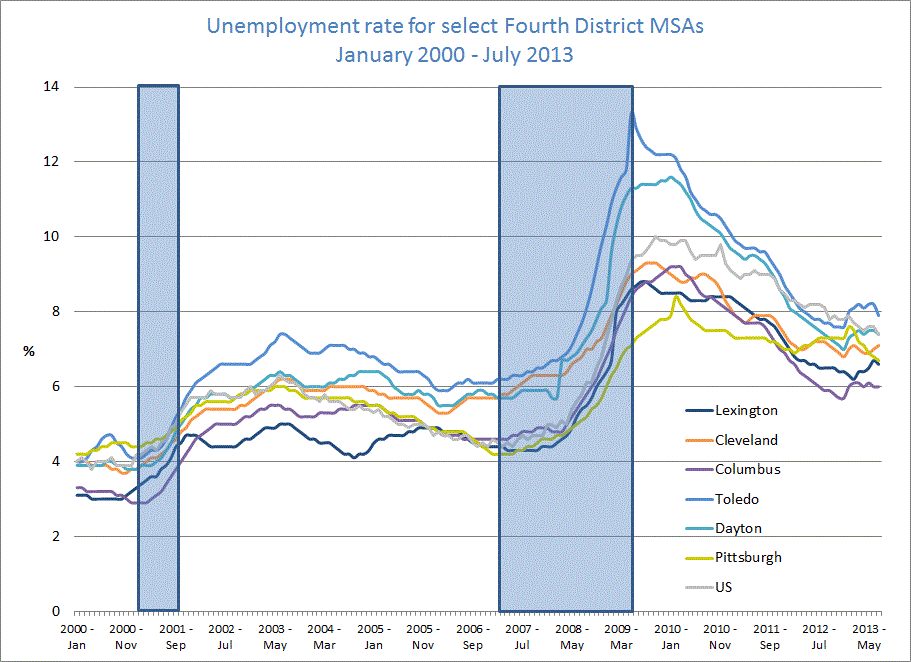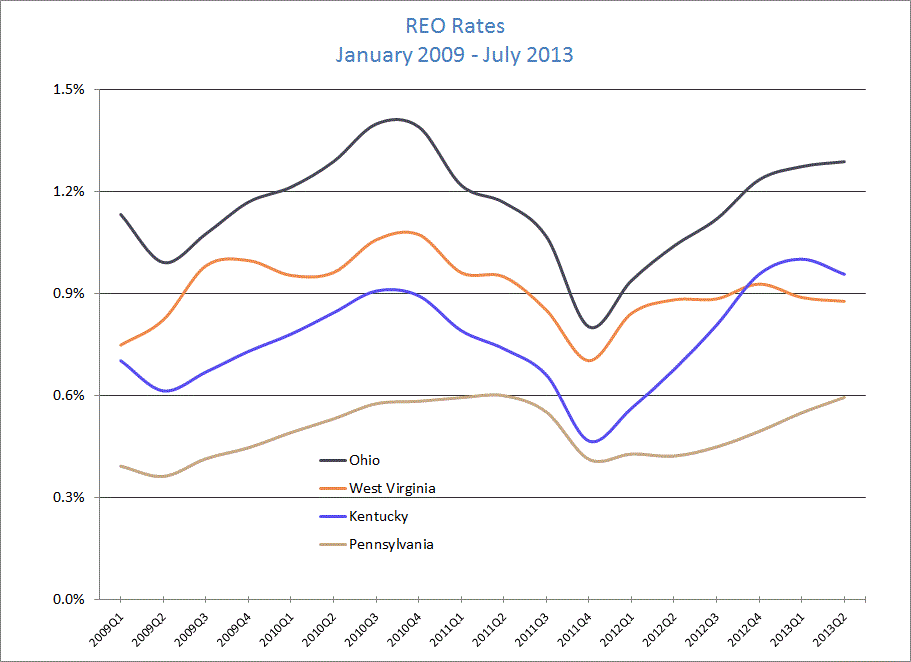- Share
Jobs, Vacant Properties Remain Top Concerns Two Years Running
In 2011, the Federal Reserve Bank of Cleveland began conducting a semi-annual community issues survey. The July 2013 survey marks the fourth time we have reached out to our stakeholders to elicit their input on the current and emerging issues confronting the communities they serve. Jobs and vacant properties have consistently ranked as top current concerns among stakeholders responding to our survey, while federal budgets cuts has constantly ranked as a top emerging concern. We received 241 responses to our July 2013 survey which gauges the stakeholders' concerns for the first half of the year and what they see as concerns a year from now.
What do survey results tell us over time?
This issue's survey is one tool we use to help gauge the major concerns facing communities. Respondents represent the perspectives of a range of institutions (see table below). One thing the consistency of our results tells us is that these top issues – jobs and vacant properties – are not specific to any particular group, industry, or community. We can also discern trends over time, which is useful in highlighting issues that remain a challenge for communities and why they continue to be such a concern. Finally, we look to these results as a driver of, and a comparative measure for, our quantitative analysis. Does what’s happening on the ground match what we’re seeing in the data? We’d love to know what you think. Contact the author or any member of our Community Development team. We listen, we learn, we investigate, we inform.
1 – Jobs stuck in first place
For the third time in four surveys, availability of local employment opportunities topped the list of concerns facing Fourth District communities, according to stakeholders who responded to our July 2013 survey. Nearly 46 percent of respondents ranked jobs as one of their top three concerns, with 21 percent ranking it as their number one concern. Regarding job availability since the beginning of 2013, most of the respondents (56%) believed it had not changed, 15 percent felt it had decreased, and 27 percent thought job opportunities had increased.
Respondents’ comments about employment opportunities focused mainly on two themes: the skill sets of job seekers and the types of jobs available. The executive director of an economic development organization commented, “Businesses need workers, and they are frustrated by the poor quality of the workforce.” Another wrote, “There seems to be a widening gap between the skills of our labor force and what our employers need.” Many wrote about the lack of quality jobs. Noted a county community and economic development director, “Too many people remain unemployed or underemployed. We see this in the number of first-time recipients [requesting] social services and food stamps.” A workforce development official wrote, “We need jobs with a family-sustaining wage,” noting also that entry level low-skill jobs are increasing “while higher-skilled jobs are either leaving the region or, due to the lack of a trained workforce, are not locating in the region.”
“Higher-skilled jobs are either leaving the region or, due to the lack of a trained workforce, are not locating in the region.”
A number of respondents expressed concern about the lack of decent job opportunities for college graduates and the impact that has on communities. A bank president wrote, “Without quality job opportunities for younger educated workers, upwardly mobile job seekers will move out of the area. The ‘brain drain’ ultimately has a very negative effect on the local economy and the quality of life in the region.” Another put in more bluntly: “Local college graduates continue to move outside Ohio for employment opportunities.” A department manager in local government expressed similar concern for the spillover effects of fewer jobs for college grads: “With limited job opportunities, the effects [extend] beyond just the individual [and] impacts taxes paid, goods purchased, and the need for services and programs.”
Unemployment rate for select Fourth District MSAs: January 2000-July 2013
Source: Bureau of Labor Statistics

2 – Vacant properties & funds to deal with them
Vacant and abandoned properties registered as one of the top three concerns for nearly a third (33%) of the stakeholders who responded to our July 2013 survey. In fact, vacant properties have been a top concern in each of our four surveys. About 57 percent reported vacancies had increased since the beginning of 2013, followed by 37 percent who indicated the problem of these empty structures had remained the same. As in past surveys, comments focused mainly on the negative impacts. According to the housing director of a community development corporation, “The large numbers of abandoned homes lower property values and increase crime. They contribute to population loss and hinder investment and confidence in the neighborhood.” Another commented, “Vacant properties affect the overall health of a neighborhood. The ability to either re-use or demolish these structures is essential to the vitality of the area.” A provider of housing services in Pennsylvania observed, “REO and foreclosed property is not being re-sold at a fast enough pace to keep up with the incoming REOs. Lenders are therefore delaying taking possession on the deeds, and this in turn contributes to the properties being vandalized.”
“REO and foreclosed property is not being re-sold at a fast enough pace to keep up with the incoming REOs.”
REO Rates: January 2009-July 2013
Source: Authors' calculations of Lender Processing Services, Inc. (LPS) data

Funds to address these problem properties were another focus of respondents’ concern. “Demolition has been done but further work needs to be completed,” wrote an economic development professional. “Our municipality is in financial emergency and currently does not have the capacity to take care of city-owned park land, let alone vacant parcels.” A planning director wrote, “Vacant and abandoned property is contributing to neighborhood blight. With reduced funds available for acquisition and demolition, this blight and its impact will become worse.”
3 – Federal budget cuts & their ripple effects
Budget cuts ranked third, with 28 percent of respondents ranking budgetary cuts and financing issues at the federal level as one of their top three concerns. This is the second time federal budgets cuts have been one of the top three concerns (it reached the number one spot in our January 2013 survey). More than 86 percent reported in our July survey that cuts had increased since the beginning of 2013.
In our analysis of survey responses, we saw three themes emerge from comments on this topic: the types of programs being cut; the impacts of cuts on individuals and communities; and exasperation with the political process. “Quality affordable housing has been steadily shrinking in this region over the past few years,” wrote an attorney with a nonprofit. “Cuts to the federal HUD budget due to sequestration, local policies discouraging construction of new subsidized housing units and reductions to local housing choice vouchers are diminishing affordable housing options.” A bank senior vice president’s comment captured the sentiments of multiple respondents: “Cuts in CDBG, decimation of HOME, and limited availability of federal tax credits reduce the tools necessary to support revitalization and critical services in distressed communities.”
Numerous respondents commented about the ripple effect federal cuts have on local communities. “Cuts at the federal level trickle down and affect state and local finances and budgets,” noted a manager of a charitable organization. “These cuts also affect the funding available to support low-income households and organizations serving these households.” A foundation director echoed this sentiment, writing, “State and local governments have been struggling for years to fund projects and programs that serve their communities and now, with the federal government cutting so deeply, many programs cannot survive. Those that do [survive] do not have the resources necessary to effectively serve their constituents.”
Several respondents expressed frustration with the political climate in the nation’s capital. “Congress continues to debate rather than act regarding the financing of infrastructure, research, and education,” opined an economic development official in local government. ”Meanwhile, local government continues to receive unfunded mandates that it cannot afford.” Many recognized the need to rein in the federal budget, though sequestration as a solution defies logic. A regional chamber of commerce vice president suggested, “Rather than across-the-board cuts, we need to evaluate programs and increase efficiencies.” Another wrote, “Federal budget cuts are not being done in thoughtful and policy-oriented ways; we are likely to see a lot of unintended consequences that local communities will have to bear the brunt of – with limited resources.”
Emerging Issues
On the horizon: More cuts, political gridlock, uncertainty
Jobs top of the list of greatest emerging issues, or concerns respondents expect they’ll face a year from now, followed by federal budget cuts and access to quality K-12 education. Comments regarding availability of local employment opportunities were comparable to those who ranked it as a top concern and focused mainly on jobseekers skills and needs of employers. A planning director remarked, “Local job opportunities are consistently one of the most important issues counties and municipalities face. Training the local workforce to fill available jobs is always a challenge.” According to the president of an economic development organization, “Businesses are concerned about jobs skills of candidates or lack thereof. Residents have skills that do not mesh with the job skills needed.” The effect of the Affordable Care Act on employment growth was mentioned by a number of respondents. A bank president wrote, “Our business clients are capping hiring and trying to determine how they will pay for Obama care.” Another commented, “Employers are hesitant to add staff due to federal policies and uncertainty involving Obama care, regulation and tax burden.”
A foundation program officer suggested the employment issue may be one of knowledge about and access to job opportunities. Jobseekers may not “have the formal and informal linkages and support systems needed to access the local job opportunities.” A CDC director confirmed this sentiment, adding, “Residents are under-employed and unemployed and seem unable to take advantage of training programs, and we need to figure out how to facilitate their access to these programs.”
“Residents are under-employed and unemployed and seem unable to take advantage of training programs, and we need to figure out how to facilitate their access to these programs.”
Federal budgets cuts were also a top emerging concern among July 2013 survey respondents. Several mentioned the impacts cuts will have on both communities and organizations. “Sequestration and reduced appropriations equal less availability of needed services, such as housing assistance for our more vulnerable populations,” commented a housing agency director. Many were concerned not only about cuts to their programs but to their own organizations’ viability. “Sequestration and other threatened cuts to various federal programs make us uneasy about our ability to stay open in the future,” stated a CDC director. Others expressed frustration with the continued political deadlock in the capital. “I see no evidence that the Congress and President are prepared to engage in rational budgeting based on appropriate compromises,” wrote a nonprofit executive director. “The federal government needs to be more fiscally responsible,” wrote a bank president. Another respondent stated, “The federal government has to lead.”
"Prospects for kids coming out of weak schools look increasingly dim"
Access to quality K-12 education is a top emerging concern among respondents for the first time since the launch of our survey. Many of the comments focused on the importance of education for economic success of both individuals and communities. “Education is paramount to opportunity potential and to one’s sustainability and continued growth. Early education establishes a framework for future educational choices, which leads to the development of a skilled workforce,” wrote a community development manager in city government. According to an executive director of a philanthropic organization, “If kids are not learning what they need to know in school, no college will admit them and no job will save them. Early investment in quality is education is absolutely essential to the region’s prosperity.”
“If kids are not learning what they need to know in school, no college will admit them and no job will save them. Early investment in quality is education is absolutely essential to the region’s prosperity.”
Funding cuts to education are a concern as well. Noted an executive director of an advocacy organization, “School funding is being cut at a time when school performance is not adequate to meet workforce needs. This area does not have an especially well-educated workforce, which contributes to companies investment decision and the creation (or not) of jobs.” Others pointed to the consequences of not having quality K-12 education. Noted one professor, “Prospects for kids coming out of weak schools look increasingly dim. If we can’t find ways to make K-12 education work better, we not only create a permanent underclass, we will also have to overcome the deadweight social costs of a significant segment of unemployed and underemployed people for the long haul. Nothing else compares regionally to this concern.”
What else is on your mind?
In addition to ranking their top current and emerging issues, we ask our community stakeholders to tell us about any additional comments or insights they may have regarding key issues in community development. Nearly three-quarters of those who responded to our July 2013 survey did just that. One theme that surfaced in numerous responses to this question was the need for collaboration to tackle issues and use limited resources wisely. A housing manager in local government wrote, “Business as usual for our municipalities is over. We absolutely must work collaboratively to minimize duplication of effort and services, undertake regional planning efforts so that limited resources can be spent in the most strategic way.” According to a planning and development director in county government, collaboration is a necessity: “The delivery of government services at the local level will continue to be an issue and will continue to have a negative impact on quality of life issues; services reductions will occur or tax burden will go up. In either case, local citizens suffer.” This respondent continued, “Though some communities will find ways to deal with revenue shortages (new taxes, service sharing, etc.), many communities are too stubborn or unwillingly to work with other communities to address issues. Until the State requires service sharing or makes it easy for jurisdictions to merge, local governments will continue to suffer and will likely result in many bankruptcy filings.”
Not everyone sees regionalism as a solution to shrinking resources. “Participation is low and alienation is high in politics,” wrote a professor. “Regional solutions will only exacerbate that issue. People feel helpless and creating larger, more remote governments unconnected to historic communities is guaranteed to worsen to the situation. There is a need to professionalize traditional units and have more inter-unit cooperation.” Another noted, “Key issues continue to be the lack of collaboration and leadership that can bridge the differences and unite business and community leaders toward a common goal of regional prosperity.” A survey respondent from a nonprofit commented, “We need a continued focus on collaboration, particularly among non-traditional partners.” Pointing out that his region has made strides in this area, the respondent added that “dwindling resources, either from public sources or individual contributions, requires a collective approach to addressing community development issues.”
Education and its importance for success generated quite a few comments from our survey respondents. A foundation president wrote, “If we don’t produce a literate workforce we will lose the jobs that we have here in Northeast Ohio. Educating our workforce to be college or career ready through an effective K-16 educational system along with effective job training and social service programs is essential to our region.” A director of a nationally accredited early childhood care organization wrote, “All children need access to quality care and education to supplement parents’ efforts – especially children in families that struggle with issues that produce toxic stress.” Children who get quality care, according to this respondent, are better positioned for healthy development and success in life, including being able to meet the demands of the complex jobs our region is trying to attract. According to a state administrator of workforce development programs, what employers are looking for and what educational institutions are providing are not quite aligned. “The careers of the future don’t all require a 2- or 4-year college degree. Discouraging employment in the trades and other careers that require less than a college degree has created a disparity in what employers need in candidates and what is being produced through academia. To fulfill employers technical needs we need to provide quality, affordable educational opportunities for non-college bound students.”
“To fulfill employers technical needs we need to provide quality, affordable educational opportunities for non-college bound students.”
| Financial institution | 49 | 20.3% |
| Academic or policy center | 36 | 14.9% |
| Community development organization | 33 | 13.7% |
| Local government | 28 | 11.6% |
| Economic development organization | 24 | 10.0% |
| Foundation | 12 | 5.0% |
| Other | 12 | 5.0% |
| Social service/health organization | 11 | 4.6% |
| Federal government | 11 | 4.6% |
| Housing counseling agency | 8 | 3.3% |
| Community development financial institution (CDFI) | 6 | 2.5% |
| State government | 6 | 2.5% |
| Legal practice/court | 5 | 2.1% |
Total |
241 |
100.0% |
| 2012 Population in District1 | Survey Response (July 2013) | |
| Ohio | 68.1% | 78.0% |
| Pennsylvania | 19.6% | 17.0% |
| Kentucky | 11.4% | 3.3% |
| West Virginia | .92% | 1.7% |
Total |
100.0% |
100.0% |
1U.S. Census Bureau, Population Division


